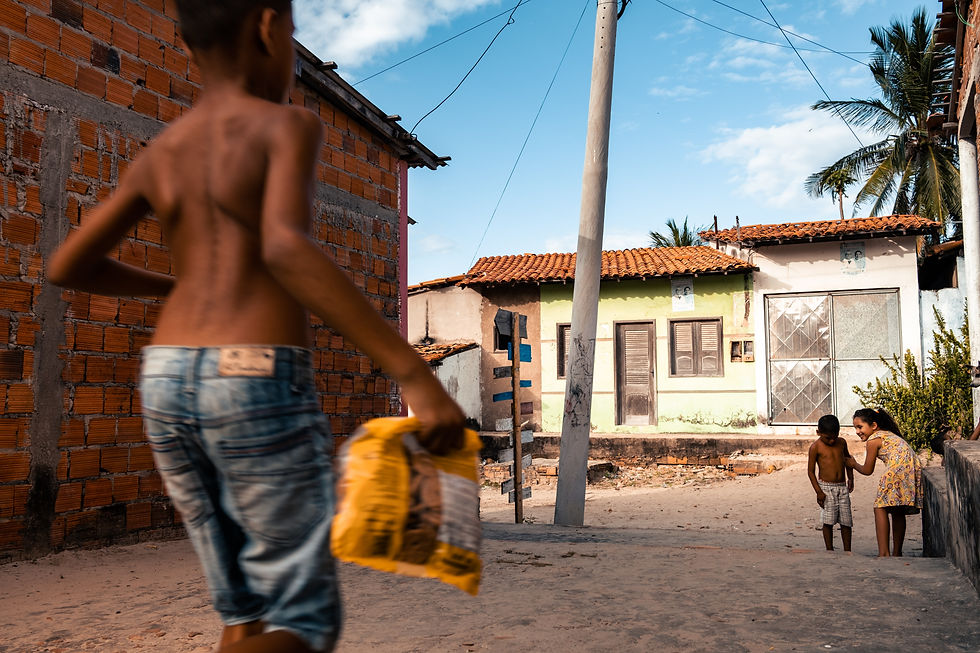Anna, Brazil & Brazilian Funk
- Monique
- 30 mei
- 11 minuten om te lezen
My friend and I have this regular thing where we meet for a creative activity at home, joined by pizza’s and a bottle of good wine. We talk about things like ambitions, men, the depressing Dutch weathers, and politics. A few weeks back, I told her about this thing I noticed while working on the portrait of Lola, the Mexican girl: how weird it is that the country that had the biggest global spice trading industry during the – so called – Golden Age, ended up with a cuisine where nutmeg is the only “outstanding” thing on the menu.
My friend, a proud well-informed Indian woman who is not afraid to speak her socialist mind, knew exactly how to respond. ‘Humanity looks down on minorities,’ she stated, before she shares how back in the days, the rich used spices to put something special on their dining table. It was their way to show that they had the luxury to buy things that were unavailable for the middle-man. But ones spices became cheaper and, with that, more available for other social classes, a propaganda started that promoted the use of only salt and pepper. It would “bring out the natural flavour of the meat”.
Up until today the West highly respects the French, who are known for “honouring the real flavours of the food”. My friend continues: ‘You know, Michelin is the biggest racist. How often do you see African or South-American restaurants represented in that guide?’ A quick check shocked me: in the 2024-edition of the guide only 0,7% of the mentioned restaurants are based in South-America, no African restaurant is represented. My friend continues: ‘It’s because since the time this propaganda started, we see the use of spices as something cheap, coming from poor, uncivilized people.’ She lifts up her finger at me. ‘While in fact, it’s not. Our cuisines are very rich!’
After years of migration, the Dutch got used to restaurants providing foreign flavours, like Chinese or Turkish, although I need to mention that most of them adapted their recipes to the Dutch tongue (read: spiced-down their food). You would say that a country where diversity is celebrated for a longer amount time doesn’t struggle with challenges like social inequality. Especially a country like Brazil, where more than 200 million people represent a melting pot of cultures and heritages, would more actively stand up against any kind of racism against minorities. Right?
But talking with Anna, the one and only Latina that offers Brazilian funk classes in Amsterdam, teaches me otherwise: ‘Funk is not fully respected, just because it is created in the favela’s.’
Meeting Anna
I am used to seeing her with a bright red lipstick, but this time she left her lips natural. She wears a similar jeans that she wears when she is teaching her classes. I’ve always been jealous of her hair: long, thick, waist-long brown hair, that she sweeps over her left or right shoulder every time it gets in her way. Her dark brown eyes have seen a lot, but show a determination that is focused on the future.

I know her as highly energetic, she doesn’t need a mic to reach the back of a crowded room. There is a fierce energy in her that makes you feel welcome the moment you enter her space. We meet on the day where Trump had put up sanctions against several Latin-American countries including Brazil for not accepting a deportation flight of Brazilian migrants. ‘You know, in one time of his life, his heart must have been broken by a Latina. Why else do you hate on them so much?’
Today, she shows me a calm, humble side. We crash down on a comfy couch, with cappuccino’s she started preparing when she knew I was almost there. She is surrounded by blankets on her right, and sleeping spaniel Juanito on her left, while she tells me about her life in Brazil, and her ambitions for herself and her business-baby The Baile Project, that she founded when she came to Amsterdam. And not to forget: the history of Brazilian funk, and its importance for Brazilian society.
Surrounded by music
Anna grows up in Brasilia, as the daughter of a DJ and a dancer. Already at the age of 6, she joins her dad to his shows, watching him perform from afar or standing next to him in his booth. She shows me a picture of her as a little girl, wearing a Barbie-pink top, next to her dad holding a proud teeth-exposing smile on his face, with in the background a wave of people dancing under neon light beams. ‘It was the time when funk just came up. He mostly played other styles, but he knew I loved it, so he always played funk when I was there!’
Even though Barbie-Anna has a smile from ear to ear, her childhood was a challenging time for her. A few years after her parents divorced, her mom got diagnosed with Lupus. Their support system was challenged to provide a balanced care for her, but also for Anna and her two brothers. In order to handle the situation the best way they could, they as kids took a lot of adult responsibilities on their shoulders on a young age. She shrugs when I ask her how that was like for her. ‘It was just something we needed to do. You know, in Brazil, when something challenges you, you find your way out. Always.’

Throughout history, Brazil is challenged with a lot of things. The big inequalities within the country can be traced back to the times of colonialism by – mostly – the Portuguese in the 1500’s, which is responsible for the start of the racism, corruption and segregation that Brazil is facing today. And still, there is so much celebration seen on the streets. Writing about the Carnaval would be a cliché, but the love for the good things in life can be found daily by the combination of fresh fruits and soul-nurturing fast food on the street’s markets, and a blend of samba, sertanejo and funk rhythms, coming from shops, cars and apartments. How do these contrasts unite? ‘Brazilians make the best out of the moment. What am I supposed to do when things are bad? Sit in a corner and be sad? No. You can create the best out of what you have in every moment.’
Creation in desperate times
The word create gets me thinking. Indeed creating is what people do when they hit rock bottom. It is creativity that blossoms in dirt. Some of the best poetry in written during depression. Artworks by Picasso and Chagall were made in the time when Montmartre counted as the home of outlaws and prostitutes. The forever desire of humanity to take back control during times where the only person you can count on is yourself, is one of the explanations of why funk got created in neighbourhoods like the favela’s. It is the favela where people’s voices are numbed by gunshots, within a country where climbing a step on the social-economic ladder counts as impossible for many.

The rise of funk is like back in the U.S., where breakdance (New York) and krumping (Los Angeles) became expressions without words, a way to claim space, a tool to be heard when nobody wanted to listen. Brazilian funk can count as a protest, created by the Afro-Brazilian community living in a structurally racist society. It’s a way for people to stand up. ‘Things have been bad for people in the favela’s for a long time,’ Anna shares with a sad but serious look in her eyes. More than the poverty and gun violence that we see in the media, in many favela’s there is a daily hustle where people have no access to basic facilities such as proper infrastructure, like roads or electricity.
True change is hard to be made in Brazil’s political climate, but Anna sees how also the people’s preference for sugarcoating is part of the problem.
Just for the fact that Funk is created in the favela’s, Anna sees how the music and the dance style that comes with it are judged by many, including by the Brazilian politics. Over the years, several attempts have been made to criminalize funk. Criticizers claim funk is related to violence and drug traffic, and would promote a lifestyle without morality. Anna acknowledges that the lyrics can be explicit and disrespectful. ‘But these are people singing about what is going on in their streets. You can’t blame them: this is their reality. Instead of looking down on the style, I think especially the people in power need to shift their attention to making things better in these neighbourhoods, rather than criticizing that it is too violent there. We need to listen more carefully to what Funk-artists are saying: this is their call for change!’

Determination
While growing up, surrounded by dance and music, she always considered herself a dancer. But the road that got her there was a bumpy one. Too many struggles within a too short time period ended up with Anna building up several health problems. By the age of 14, she didn’t care about life as much as she used to. It was her teacher who noticed her: she kept inviting her to one of the dance classes after school. Anna didn’t feel like going for a long time, but at some point, it was her Brazilian mindset of making the best out of life that made her sign up and call her friend to invite her to join her.
In that dance class, Anna finds herself again. ‘It was like I was fighting a demon.’ She moves her hands over her body to show how much she was sweating, rubbing her fingers through her hair to show how messy it looked at the end of the class. She found her heartbeat racing, there was an energy that had been absent for such a long time. All the monsters she was continuously fighting disappeared to the background. ‘Of course I still had a long way of recovery to go, but this is where my recovery started. Through dance.’

Hustling
She is determined to continue to dance, and quickly the classes became an addiction, an escape out of her head and into a reality that started to look exciting again. In order to pay for the classes, she took a job as a cashier in a drugstore and besides that, she started to sell home-made pastries, brigadeiros, little balls covered with chocolate sprinkles. For the festivals, she specially made caipirinhas, a classic Brazilian cocktail with lots of lemons. She laughs: ‘I would go to pubs, bars, in the evening or during the night. I sold the most during carnivals, sometimes I made like €100,- per day.’

Anna invested all she earned into her dance classes. It blessed her with being able to dance every day, learning different styles and becoming good enough to join groups with who she performed at several events and festivals. She remembers that her mom came to one of her first shows, and automatically starts to smile: ‘She was so proud.’
One shot
Her love for dance continues to grow, and she signs up for Performing Arts at the University of Brasilia. Where in The Netherlands the biggest challenge would be to get through an audition, things in Brazil are – again – more challenging. Anna explains that in Brazil both public and private education are offered. Although the public universities provide a free high quality level of education, it are the public high schools that are far behind the quality of the education that is offered at the private high schools. They are known for the best kind of education, but yet, unaffordable for the majority of the people.
For a long time, students from both the public and the private high schools would compete for the few available spots at the university. You can imagine that with this kind of segregation within the system, all college seats were taken by the privileged. With that, Brazilians who didn’t belong to the upper classes were unlikely to get accepted for university. It was the government of Dilma that wanted to increase the social-economic chances of the people from the lower classes. They created the lei das cotas, where a percentage of the available seats in the public universities will be reserved for students from the public schools.

Anna was one of the lucky ones who got accepted. She still gets excited when she thinks back about her time there. ‘I had dance, theatre, acting, I felt amazing over there.’
Creating The Baile
After years of hard work she earns her degree and gets the opportunity to continue her journey as a dancer in Europe. She gets an invitation to perform at a festival in Prague. From there, she ends up in Amsterdam, where she starts her journey as a dance teacher and – soon – starts to build her own cultural company.
She named that company The Baile Project, where baile stands for the name of the parties where funk music gets played. ‘I didn’t have a stable place where I could teach, every week I taught my classes at a different location.’ Ones the Covid-restrictions loosened up and her number of regular students increased, she found a location where she signed a rental contract for the use of one of the studio’s for a full year on the same days, same times. This is where she could start promoting her business more.

From the start, The Baile is more than just a place to dance. ‘With Baile, I want to connect people, give everybody a place to show themselves, and see cultures blend together.’ She is proud for seeing Brazilians, Dutch and people from many other different backgrounds joining her classes. She believes that dance is a great tool to connect with each other and meet different realities. ‘It can be tough to feel like you don’t belong in a new place. But unfortunately, that is still a very common feeling, especially among immigrants.’
She continues: ‘We all have something to offer, something to say. And we can all learn from each other, no matter where we come from.’ She sights. ‘Yes, making people fall in love with Brazil, the latin culture, funk… And with that to make people grow an interest in each other’s cultures, beyond stereotypes and racism, while dancing! Yes, that is my goal.’
The dream continues
Since funk got created, it has been evolving. The music found its way out of the favela’s to the mainstream media, women stepped in and claimed their space in the men-dominated genre, and the style found international appreciation, this latest especially thanks to Anitta, funk’s number one global ambassador.
Since the first day she stood next to her father in the DJ-booth, Anna developed herself from a dancer, to a teacher, to a creative business owner. Her next plan is to go international and bring The Baile Project to Brazil.

She sits back to think carefully about what she is about to say. ‘You know, sometimes I wonder if I am the one who should even teach Brazilian funk here. I am the only one teaching the style here now, and I love everything about it. But even though I teach the style with all the respect and appreciation that I can give it, it is a style that is created by the lower class communities. More than that: it is a black-Brazilian style! While I am teaching it here and being praised for it, the real creators of the style are still there, in the favela’s, still suffering from the criticism and racism. It is an unfair reality.’
‘I believe that the real story can best be told by the real creators. They deserve to get opportunities to get better lives for themselves. For myself it means that as long as I am building a business that involves funk, I need to take the responsibility. Not only by staying respectful, include storytelling about their history into my classes, but also by opening up opportunities for them. There is still so much gratitude we can show them, so much more recognition to give. I would like to do my part to honour them and the legacy they have built, by offering The Baile as a platform.’

The future of funk
Despite its global recognition, funk still counts as controversial. But is has earned its place and is not planning to give it up. Throughout history, not only funk but also the now-celebrated samba and capoeira faced misinterpretation and discrimination. But it is the belief in people’s right of expression and freedom of speech that have always won over the desire by the powerful few that it should be criminalized or even banned from society. With that, I feel a hope for funk to continue to challenge boundaries.
I guess it can be said that humanity struggles with things that are new or different. After centuries filled with conflict, exclusion and execution, we are still likely to prefer judgement over finding ways for understanding. But let’s learn from Anna, and focus on what we can do within our own circle of influence: set your goal, create moments of happiness in every part of the journey, and spread your message through a beautiful blend of a punchline, wrapped in a sweet – not too thick – coat of sugar, and present it to the world by the artform that suits your soul.






Opmerkingen